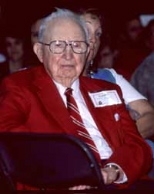The oldest man attending this year's reunion events may also have been the busiest. Yardley Chittick (SB 1922) of Concord, NH had to pull double duty this year when his high school alma mater, Phillips Academy in Andover, MA, scheduled its reunion the same weekend as MIT.
The 100-year old Mr. Chittick ("Yard" to friends) tries to attend MIT reunions most years even though not many of his classmates show up these days. His last close friend who was an alumnus died a few years ago. Malcolm Burroughs (Class of 1920) was always the oldest alumnus at reunions. "I seem to have taken his place," said Mr. Chittick with a laugh.
"I'm an entirely undistinguished person in industry and intellectually," he said. "All I've managed to do is stay alive longer than anybody" -- a feat he's accomplished without the help of pills except for an occasional Benadryl, he said. "Most people this age are pill-takers. But think of the money you save if you don't take any."
Mr. Chittick worked most of his life in Boston as a patent attorney at a firm bearing his name. His wife, Ruth (Gardner), died three years ago; he moved to a retirement home in New Hampshire at about that time.
He attends class reunions "out of force of habit and interest in the Institute. But I'm quite deaf. I can't understand anything in Kresge. The speaker talks and says something that must be very amusing and I see the audience laugh," said Mr. Chittick.
He was born October 22, 1900 and found that the centennial year proved to be "a big help when you're trying to figure out how old you were on a certain date. It's very simple." At Andover, he lived for one year across the hall from Humphrey Bogart ("Humphrey deForest Bogart with a small D," he said), who was a couple of years younger. "He didn't like me and I didn't like him. We came out even on that."
Mr. Chittick earned the SB from MIT in 1922 in engineering administration with a mechanical engineering option, a course that has since been absorbed by the Sloan School. A golfer for 50 years ("an average golfer with a handicap of nine"), he still remembers the day in 1928 in Ft. Meyers when he got a hole in one and shot a 74 -- his best game, "one of those days when all the putts went in," he said.
He even turned down a chance to work for Thomas Edison in 1925 so he could stay close to the game. "I had to tell Mr. Edison 'Thanks, but no thanks.' I went to work for a company that manufactured golf clubs. I guess I was more interested in golf than I was in a laboratory." Mr. Chittick later worked as a patent examiner for the government while attending George Washington University law school at night before the days of air conditioning. "Washington in the summer was the hottest place in the world," he said. He earned the LLB in 1933 and went on to practice law in Boston, patenting mechanical inventions.
Mr. Chittick keeps up with his fraternity, Beta Theta Pi, and attended dinner at the house at 119 Bay State Rd. a couple of weeks ago. "It was at 179 Bay State Rd. my freshman year, 306 Bay State Rd. my sophomore year, and Sewell Avenue in Brookline" his junior and senior years.
Asked how he felt about his young fraternity brothers, he said, "The undergraduates looked like a bunch of bums. They were sitting around outside on the marble steps in the most unattractive clothing imaginable. But they changed clothes and didn't look so bad for dinner."
The former member of the Alumni Council has attended almost all of his reunions. About three dozen members of his Class of 1922 survive, including Malcolm McGhie, whom Mr. Chittick remembers from college, although they were in different fraternities. His son Charles Yardley Chittick Jr. (SB 1950, SM) also attended MIT.
A version of this article appeared in MIT Tech Talk on June 13, 2001.






